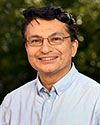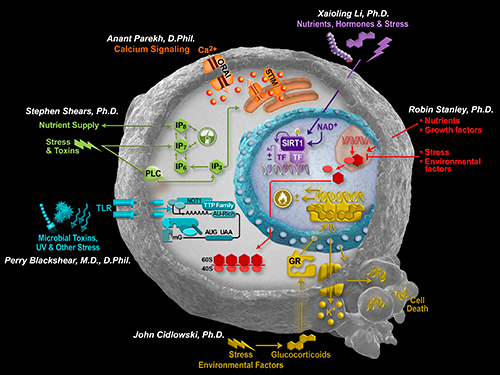-

-
Anant B. Parekh, D.Phil.
Chief, Molecular & Cellular Biology Laboratory;
Senior Investigator -
Tel 984-287-4545
[email protected] -
P.O. Box 12233Mail Drop F2-02Durham, NC 27709
-

-
John A. Cidlowski, Ph.D.
Deputy Chief, Molecular & Cellular Biology Laboratory;
Senior Investigator -
Tel 984-287-3545
Fax 919-541-1367
[email protected] -
P.O. Box 12233Mail Drop F3-06Durham, NC 27709
Research Summary
The overall goal of the Molecular and Cellular Biology Laboratory is to define the mechanisms that cells, tissues and organisms use to respond to physiological and environmental stimuli. Responses of cells to environmental signals, toxins and stressors have profound implications for diverse aspects of human health and disease including development, cystic fibrosis, diabetes, asthma, heart, autoimmune diseases and cancer.
The delineation of the signal transduction pathways affected in these and other complex human diseases is likely to present new avenues for therapeutic intervention and understanding of human disease mechanisms. The Molecular and Cellular Biology Laboratory seeks to achieve this goal through cutting edge basic research and training of junior scientists in aspects of environmental health related science that are critical to the mission of NIEHS. It is anticipated that research in signal transduction will have a central role in environmental human health in the post-genomic era.

The Molecular and Cellular Biology Laboratory investigates the following topics:
- Glucocorticoid receptors and their actions in genetically modified animals
- Mechanisms involved in the regulation of apoptosis in normal and neoplastic cells
- Intracellular Ca2+ pools involved in cellular signaling, and the basis for intracellular [Ca2+]i oscillations
- Inositol phosphate family of intracellular signals, and their responses to environmental insults
- Gene-environment interactions in metabolism and metabolic diseases, with focus on sirtuins, post translational modifications, and epigenetics
- The roles played by a small family of CCCH tandem zinc finger proteins in the physiological regulation of mRNA turnover and responses to environmental stimuli
- Molecular mechanisms governing eukaryotic ribosome biogenesis
Scientific Support Staff
-

-
Carol J. Coatney
Administrative Specialist -
Tel 984-287-3498
[email protected]
-

-
Judy L. Bartz
Administrative Technician -
Tel 984-287-3497
[email protected]
-

-
Robert S. Blake
Administrative Technician -
Tel 984-287-3499
[email protected]


